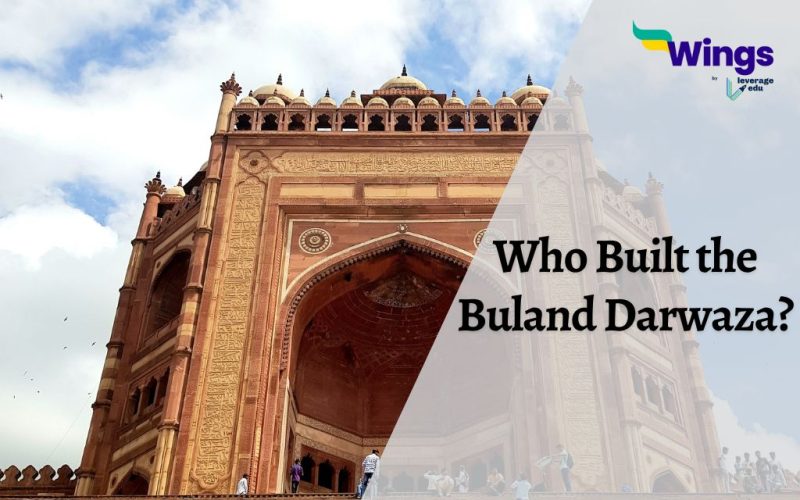The Door of Victory or the Buland Darwaza was built by the great Mughal emperor, Akbar. It was established in 1601 and commemorates his glorious victory over Gujarat. Moreover, it stands as the highest gateway in the world and is a breathtaking example of the famous Mughal architecture. The Buland Darwaza shows an astounding mix of Hindu and Persian styles of architecture which further makes it a miraculous wonder to ponder upon. In this blog, we will explore its historical background, architectural details, and more.
| Name of the architecture | Buland Darwaza |
| Year of construction | 1601 |
| Total time taken | 12 years |
| Location | Fatehpur Sikri, Agra, Uttar Pradesh, India. |
History of the Buland Darwaza
- The Buland Darwaza was constructed by emperor Akbar who laid the foundations of the Mughal empire in the Indian subcontinent.
- It was built to commemorate his famed victory over the region of Gujarat, India.
- He launched the campaign in 1572 and conquered victory in 1573.
- It all happened during the reign of Ahmad Shah III and Mahmud Shah III, the last two Sultans of Gujarat.
- Interestingly, the Buland Darwaza was not included in the original plan for the Jama Masjid.
- The Buland Darwaza is among the most popular tourist destinations in India. Most importantly, it has been recognized as a UNESCO World Heritage Site.
Also Read: Babur: The Magnificent History of the First Mughal Emperor
Architecture of the Buland Darwaza
- The Buland Darwaza is a gateway that offers visitors a southern entrance into the city of Fatehpur Sikri.
- It is semi-octagonal in plan and features pillars and chhatris at the top. These simple yet elegant details throw light on the intricate beauty of the Mughal architecture.
- It is also the main entrance to the Jama Masjid which is located at the Fatehpur Sikri Complex.
- The Darwaza is made using red and yellow sandstone. Moreover, it is beautifully decorated with black and white marble inscriptions.
- The central arch of the architecture is about 40 meters high.
- The height of the Buland Darwaza from ground level is 54 meters (approximately 15 storeys).
- There are 42 stairs at the ground level which lead to the gateway.
- Additionally, there are three kiosks or small hut structures at the top which are further surrounded by thirteen smaller domed kiosks.
- This massive piece of Mughal architecture is adorned with numerous intricate carvings. For instance, visitors can expect to see different floral designs, geometric patterns, animals, and Quran verses.
- Additionally, visitors can also see mesmerizing calligraphy on the Darwaza which includes verses from the Quran and praises of Akbar.
Inscriptions Engraved
- The eastern archway of the most esteemed Buland Darwaza is honored with numerous Persian inscriptions.
- These engravings bear the resemblance of the glorious victories of Mughal Emperor Akbar over Uttar Pradesh and Gujarat.
- Another inscription talks about the advice of Jesus Christ to his beloved followers in which he tells them not to consider earth as their permanent home.
- Apart from this, another inscription on the Buland Darwaza was done by Khwaja Hussain Chisti, a disciple of the Sufi Saint of the Chisti Order, Sheikh Salim Chisti. However, this particular inscription is carved in Naskh which is a popular calligraphy for Arabic alphabets.
Also Read: Life & Accomplishments of Aurangzeb: The Least Favorite Mughal
How to Reach Buland Darwaza?
- Airport- The nearest airport to Buland Darwza is the Agra Airport or the Pandit Deen Dayal Upadhyay Airport. It is located at a distance of about 38 kilometers. Visitors can easily cover this distance using a four-wheeler or any other vehicle.
- Railway station- The nearest railway station to this magnificent monument is the Agra Railway Station. It is located at a distance of 37 kilometers. Additionally, the Fatehpur Sikri Railway Station is another good option at 800 meters only. However, only a few passenger trains halt at this station.
- Bus stand- The nearest bus stand to reach the Buland Darwza which is just 35 kilometers away. On the other hand, the Idgah Bus Stand and the Agra Fort Bus Stand is other popular choice which is at a distance of 38 kilometers.
FAQs
The famous Buland Darwaza was built by Mughal emperor Akbar in the year 1575 to commemorate his ultimate victory over Gujarat.
Fatehpur Sikri is famous for a bunch of different reasons. It was built during the 16th century by Emperor Akbar of the Mughal Empire. Moreover, it was the capital of the Mughal Empire for over 10 years. Apart from this, it is renowned for its magnificent architecture and the largest and most famous mosque in India, the Jama Masjid.
Fatehpur Sikri was built by the famous Mughal Emperor Jalal-ud-din Mohammad Akbar. It was primarily established to pay tribute to and honor the great Sufi Saint known as Sheikh Salim Chisti. Even after so many decades of its establishment, Fatehpur Sikri remains the epitome of the best architectural achievements of the Mughal Sultanate.
This blog was all about the Buland Darwaza was built by. If you want to read more such informative blogs on Indian History, then stay tuned with our dedicated page on General Knowledge.
 One app for all your study abroad needs
One app for all your study abroad needs













